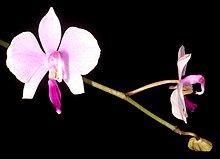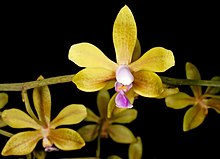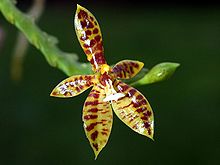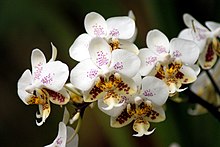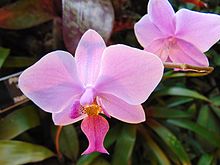Phalaenopsis
| Phalaenopsis | ||||||||||||
|---|---|---|---|---|---|---|---|---|---|---|---|---|

Phalaenopsis philippinensis |
||||||||||||
| Systematics | ||||||||||||
|
||||||||||||
| Scientific name | ||||||||||||
| Phalaenopsis | ||||||||||||
| flower |
The genus Phalaenopsis belongs to the family of orchid (Orchidaceae) and includes a variety of exotic species . The botanical name is derived from the Greek words phalaina (φάλαινα; dt. "Moth", cf. Phaläne ) and opsis (ὄψις; dt. "Sight"), as their flowers are reminiscent of tropical moths. In the German-speaking area these orchids are called "butterfly orchids", "moth orchids" or "Malay flowers".
Phalaenopsis is mainly known and loved as an ornamental plant, especially the countless large-flowered hybrids enjoy worldwide fame and growing demand. Millions of potted plants are sold annually in supermarkets , hardware stores and garden centers and as cut flowers in florist shops. Pure species and certain hybrids are sometimes coveted collector's items. Phalaenopsis were first mentioned around 1704, the first artificial hybrids were bred around 1886 in Chelsea near London . Phalaenopsis originally come from the tropical rainforests of Southeast Asia .
description
Appearance, leaves and roots
Without exception, all species are characterized by monopodial growth, that is, they only grow upwards and usually do not develop any side shoots. Most species grow epiphytically , i.e. on the branches and twigs of trees or on their trunks; some species live on moss-covered rocks ( lithophytic ).
The two to six two-line (distich) growing, more or less leathery leaves vary in shape, color and size from species to species. The smallest species with leaf lengths of up to 10–40 cm and only moderately leathery leaves such as Phalaenopsis appendiculata differ very clearly from the large specimens such as Phalaenopsis gigantea , which have leaf lengths of up to 100 cm and more and can have very fleshy leathery leaves . Their leaf color ranges from monochrome light to dark green as in Phalaenopsis amabilis and Phalaenopsis gigantea . Some species have silvery spotted leaves, for example Phalaenopsis stuartiana and Phalaenopsis schilleriana . Usually one to two new leaves per season grow out of the “heart” of the plant, while one or two leaves at the lower end of the stem turn yellow, dry up and fall off.
The numerous smooth and fleshy roots develop at the base of the stem axis or at the lower nodes, partly between the leaves. They are between one and eight millimeters thick and, in addition to absorbing nutrients and water, also serve as adhesive organs. Some species are deciduous due to the climatic conditions at the site. They therefore have roots containing chlorophyll . In addition, the roots are surrounded by the Velamen radicum .
Inflorescences and flowers
The inflorescences arise on the side of the short stem axis under or between the leaves. They grow upright, arched overhanging or hanging. Some species bloom from the same inflorescence for several years, while others form one or more inflorescences every year. Their length varies from a few centimeters to 100 cm and more. In some species, especially hybrids, the plants repeatedly re-bloom from the internodes if the inflorescence is not completely removed.
The hermaphrodite, zygomorphic (monosymmetrical) flowers are threefold. The flower size varies in diameter from 1–2 cm up to 15 cm (in some hybrids even more). The structure of the flowers ranges from delicate to waxy- firm. They consist of three sepals (sepals) and three petals , the lip (labellum) is formed from a petalum , which is always divided into three parts and consists of a spatula-shaped central lobe and two side lobes. In species like Phalaenopsis stuartiana, the middle lobe is equipped with two tail-like appendages (cirrhi) at its end. The center of the flower is the anther with callus and stigma , at the tip of which a special protective cap hides the pollinia .
Multiplication
The reproduction occurs mainly by seed or by Kindel education .
Wood bees have been observed several times as pollinating insects, and other insects are also accepted as pollinators. If a visitor lands on the lip of the flower to look for nectar on the callus or to mate the flower (in the mistaken belief that he has a love partner of his own kind in front of him), the anther's protective cap breaks off when crawling backwards and gets broken Pollen packet attached to the back with a sticky appendage. When looking for the next flower, the insect strips off the pollen package on the underside of the column, where it remains in a special recess. If pollination is successful, the scar closes.
In a few species such as Phalaenopsis violacea , a special phenomenon could be observed that also occurs in other orchid genera such as Cymbidium and Vanda : After successful pollination, the petals do not wither or fall off, they just recede somewhat, turn green and remain until they are complete Ripeness of the seeds. It is assumed that this metamorphosis of the flowers is supposed to promote the ripening of the seeds by means of additional photosynthesis .
Keiki for vegetative reproduction are often formed on the inflorescences of some species such as Phalaenopsis lueddemanniana . This phenomenon was first observed and documented in 1894. The species Phalaenopsis stuartiana forms adventitious plants at the root ends . While genetically identical plants are created through the formation of Kindeln, which can often be able to flower themselves within a year, propagation by seeds takes significantly longer. The ripening time of the capsule fruits is between 5 and 15 months for the individual species. In the case of artificial sowing, it takes another three to ten years for the plant to flower.
distribution
The species of the genus Phalaenopsis occur mainly in the Philippines and the Indonesian islands . The distribution area extends from Bhutan via Myanmar , southern China , Taiwan , the Malay Peninsula to Queensland in northern Australia.
The locations are mostly characterized by daytime temperatures of 25 ° C to 35 ° C and night temperatures of 15 ° C to 25 ° C, high amounts of precipitation during the growing season and high humidity all year round. Occasionally, the conditions of some habitats are characterized by significantly lower temperatures, especially during the winter months, Phalaenopsis lobbii, for example, can withstand temperatures as low as 5 ° C. The plants grow predominantly in partial shade to light, without direct sunlight. Occasionally there are habitats in full sun.
Botanical history
The genus was given the botanical name Phalaenopsis by the Swedish zoologist and botanist Carl von Linné around 1753. When he saw the flowers, he was reminded of moths of the genus Phalaena (today: Biston ) flying around .
The first species of the genus was described as early as 1704 by Georg Joseph Kamel under the name Visco-Aloes Luzonis decima quarta in John Ray's botanical work " Historia Plantarum " (Volume 3). It was a plant of the species Phalaenopsis aphrodite . The genus itself was established in 1825 by the botanist Carl Ludwig Blume . Around 1860, HG Reichenbach presented a first summary of all previously known species in the Hamburger Garten- und Blumenzeitung and expanded it in 1862 by adding 11 new discoveries.
The first artificially produced hybrid blossomed in 1886 at the company Veitch and Sons . It was the cross between Phalaenopsis "Intermedia" ( Phalaenopsis aphrodite × Phalaenopsis equestris ). This cross was later found in imports as the natural hybrid Phalaenopsis × intermedia . In 1897 Phalaenopsis "Harriettiae" ( Phalaenopsis amabilis × Phalaenopsis violacea ) and Phalaenopsis "FL Ames" ( Phalaenopsis "Intermedia" x Phal. Amabilis ) also bloomed for the first time.
Systematics
The genus Phalaenopsis was established in 1825 by Carl Ludwig Blume in Bijdragen tot de flora van Nederlandsch Indië . Type species is Phalaenopsis amabilis (L.) Blume . Synonyms for Phalaenopsis flower are: Polychilos Breda, Kuhl & Hasselt , Doritis Lindl. , Synadena Raf. , Stauroglottis Schauer , Polystylus Hasselt ex Hassk. , Stauritis rchb. f. , Kingiella Rolfe nom. illeg., Grafia A.D.Hawkes nom. illeg., Kingidium P.F.Hunt , Lesliea Seidenf. , Grussia M. Wolff .
The genus Phalaenopsis belongs to the subtribe Aeridinae , so in the relationship to the genus Aerides , from the tribe Vandeae in the subfamily Epidendroideae within the family Orchidaceae . The closest relatives of Phalaenopsis are the genera Grosourdya and Pteroceras , these three represent the basal group within the subtribes, which is the earliest separated from the other genera.
In addition to the approximately 100 species , varieties , forms and natural hybrids, there is now an unmanageable number of cultivated hybrids.
Outline of the genus
Since there are different views in the professional world about the membership of some species in the genus Phalaenopsis , it is difficult to give an exact overview of the species; in particular the inclusion of the genera Doritis and Kingidium in Phalaenopsis is controversial. The classification in this article is based on the revision of the genre by EA Christenson from 2001.
According to EA Christenson 2001, the genus is divided into five sub - genres :
- Proboscidiodes
- Aphyllae
- Parishianae
- Polychilos (with the sections Polychilos , Fuscatae , Amboinenses and Zebrina )
- Phalaenopsis (with the sections Phalaenopsis , Deliciosae , Esmeralda and Stauroglottis )
The status of some of the taxa on this list is unknown or uncertain. This is mainly due to the fact that, like Phalaenopsis robinsonii, they have long been considered lost.
Species within the subgenus and sections
The following list of species, structured according to subgenera and sections , is based on the monograph by EA Christenson from 2001, the list of species is also based on the World Checklist of Selected Plant Families of the Royal Botanic Gardens (Kew) .
- Subgenus Proboscidiodes (Rolfe) EAChrist.
- Phalaenopsis lowii Rchb.f. : It occurs in Myanmar and Thailand.
- Subgenus Aphyllae (Sweet) EAChrist.
- Phalaenopsis taenialis (Lindl.) Christenson & Pradhan (Syn .: Kingidium taeniale (Lindl.) PFHunt , Kingidium braceanum (Hook.f.) Seidenf. ): It occurs from the Himalayas to Yunnan.
- Phalaenopsis finleyi E.A.Christ. (Syn .: Kingidium minus Seidenf. ): It occurs in Thailand, Myanmar and Vietnam.
- Phalaenopsis wilsonii Rolfe : It occurs from southern China to northern Indochina.
- Phalaenopsis stobartiana Rchb. f. (Syn .: Phalaenopsis hainanensis Tang & FTWang ): It occurs in Hainan .
- Phalaenopsis honghenensis F.Y.Liu : It occurs from Yunnan to Vietnam.
- Phalaenopsis natmataungensis (T.Yukawa, Nob.Tanaka & J.Murata) Dalström & Ormerod : It occurs in northern Myanmar.
- Subgenus Parishianae (Sweet) EAChrist.
- Phalaenopsis appendiculata Carr : It occurs in Malaysia.
- Phalaenopsis gibbosa H.R.Sweet : It occurs in Yunnan and Vietnam.
- Phalaenopsis lobbii (Rchb.f.) HRSweet : It occurs from the eastern Himalayas to Yunnan.
- Phalaenopsis parishii Rchb.f. : It occurs from eastern Nepal to Indochina.
- Phalaenopsis thailandica O.Gruss & Roeth : It occurs in Thailand.
- Subgenus Polychilos (Breda) EAChrist.
- Section Polychilos (Breda) Rchb. f.
- Phalaenopsis mannii Rchb.f. : It occurs from eastern Nepal to southern Yunnan.
- Phalaenopsis cornu-cervi (Breda) flower & Rchb.f. (Syn .: Phalaenopsis borneënsis Garay ): It occurs from Bangladesh to western Malesia and the Philippines.
- Phalaenopsis pantherina Rchb.f. : It occurs in Borneo.
- Section Fuscatae Sweet
- Phalaenopsis cochlearis Holttum : It occurs in Malaysia and Borneo.
- Phalaenopsis viridis J.J.Sm. : It occurs in Sumatra.
- Phalaenopsis fuscata Rchb.f. : It occurs in Malaysia, Borneo and the Philippines.
- Phalaenopsis kunstleri Hook. f. : It occurs in Malaysia and Myanmar.
- Section Amboinenses Sweet
- Phalaenopsis pulchra (Rchb.f.) HRSweet : It occurs in the Philippines.
- Phalaenopsis violacea H.Witte : It occurs in Malaysia and Sumatra.
- Phalaenopsis bellina (Rchb.f.) Christenson : It occurs in Borneo.
- Phalaenopsis micholitzii Sander ex HJVeitch : It occurs in the Philippines.
- Phalaenopsis fimbriata J.J.Sm. : It occurs in Borneo, Java and Sumatra.
- Phalaenopsis floresensis Fowlie : It occurs on Flores .
- Phalaenopsis robinsonii J.J.Sm. : It occurs on Ambon .
- Phalaenopsis gigantea J.J.Sm. : It occurs on Borneo.
- Phalaenopsis fasciata Rchb.f. : It occurs in the Philippines.
- Phalaenopsis doweryënsis Garay & Christenson : It occurs in Sabah .
- Phalaenopsis modesta J.J.Sm. : It occurs in Borneo.
- Phalaenopsis maculata Rchb.f. : It occurs in Malaysia and Borneo.
- Phalaenopsis javanica J.J.Sm. : It occurs in western Java.
- Phalaenopsis mariae Burb.ex R.Warner & H.Williams : It occurs from Borneo to the Philippines.
- Phalaenopsis amboinensis J.J.Sm. : It occurs from Sulawesi to the Moluccas.
- Phalaenopsis lueddemanniana Rchb.f. : It occurs in the Philippines.
- Phalaenopsis venosa Shim & Fowlie : It occurs on Sulawesi.
- Phalaenopsisreichenbachiana Rchb.f. & Sander : It occurs in Mindanao .
- Phalaenopsis rundumensis P.J. Cribb & ALLamb : It occurs in Sabah .
- Phalaenopsis pallens (Lindl.) Rchb.f. : It occurs in the Philippines.
- Phalaenopsis bastianii O.Gruss & Roellke : It occurs in the Philippines.
- Phalaenopsis hieroglyphica (Rchb.f.) HRSweet : It occurs in the Philippines.
- Section Zebrina Pfitz.
- Phalaenopsis inscriptiosinensis Fowlie : It occurs in Sumatra.
- Phalaenopsis tetraspis Rchb.f. (Syn .: Phalaenopsis speciosa Rchb.f. ): It occurs in north-western Sumatra, on the Andamans and Nicobars .
- Phalaenopsis corningiana Rchb.f. : It occurs in Sarawak .
- Phalaenopsis sumatrana Korth. & Rchb.f. (Syn .: Phalaenopsis zebrina Witte ): It occurs from Indochina to western Malesia and Palawan .
- Section Polychilos (Breda) Rchb. f.
- Subgenus Phalaenopsis
- Section Phalaenopsis
- Phalaenopsis philippinensis Golamco ex Fowlie & CZTang : It occurs on Luzon .
- Phalaenopsis stuartiana Rchb.f. : It occurs in the Philippines.
- Phalaenopsis amabilis (L.) flower : It occurs in three subspecies from Malesia to New Guinea and Queensland.
- Phalaenopsis aphrodite Rchb.f. : It occurs in two subspecies from the Philippines to southern Taiwan.
- Phalaenopsis sanderiana Rchb.f. : It occurs in the Philippines.
- Phalaenopsis schilleriana Rchb.f. : It occurs in the Philippines.
- Section Deliciosae E.A.Christ.
- Phalaenopsis chibae T.Yukawa : It occurs in Vietnam.
- Phalaenopsis deliciosa Rchb.f. (Syn .: Kingidium deliciosum (Rchb.f.) HRSweet ): It occurs in two subspecies from the Indian subcontinent to Malesia and southern Yunnan.
- Phalaenopsis mirabilis (Seidenf.) Schuit. : It occurs in Thailand.
- Phalaenopsis mysorensis C.J.Saldanha : It occurs in southern India.
- Section Esmeralda Rchb. f. (This section originated from the formerly monotypical genus Doritis )
- Phalaenopsis buyssoniana Rchb.f. : It occurs in Thailand and Vietnam.
- Phalaenopsis pulcherrima (Lindl.) JJSm. (incl. Phalaenopsis regnieriana Rchb.f. ): It occurs in four varieties from Assam to Hainan and in western Malesia.
- Section Stauroglottis (shower) Benth.
- Phalaenopsis equestris (shower) Rchb.f. : It occurs from the Philippines to southern Taiwan.
- Phalaenopsis celebensis H.R.Sweet : It occurs in Sulawesi.
- Phalaenopsis lindenii Loher : It occurs in the Philippines.
- Section Phalaenopsis
- Without assignment to a sub-genus or section:
- Phalaenopsis boulbetii (Telepova) JMHShaw : It occurs in Cambodia.
- Phalaenopsis cacharensis (Barbhuiya, BKDutta & Schuit.) Kocyan & Schuit. : It occurs in Assam.
- Phalaenopsis difformis (Wall. Ex Lindl.) Kocyan & Schuit. : It occurs in two varieties from the Himalayas to southern China and western Malesia.
- Phalaenopsis hygrochila J.MHShaw : It occurs from Assam to China and Indochina.
- Phalaenopsis japonica (Rchb.f.) Kocyan & Schuit. : It occurs in China, Korea and from Japan to the Nansei Islands.
- Phalaenopsis kapuasensis Metusala & P.O'Byrne : It occurs in Kalimantan .
- Phalaenopsis marriottiana (Rchb.f.) Kocyan & Schuit. : It occurs in China and Myanmar.
- Phalaenopsis mentawaiensis O.Gruss : It occurs in Sumatra.
- Phalaenopsis subparishii (ZHTsi) Kocyan & Schuit. : It occurs in southern China.
- Phalaenopsis tsii (MHLi, ZJLiu & SRLan) Hua Deng, ZJLiu & Yan Wang : It occurs in the Chinese province of Hunan .
- Phalaenopsis ubonensis (O.Gruss) JMHShaw : It occurs from Thailand to Laos.
- Phalaenopsis yingjiangensis (ZHTsi) Kocyan & Schuit : It occurs in southwestern Yunnan.
- Phalaenopsis zhejiangensis (ZHTsi) Schuit. : It occurs in the Chinese province of Zhejiang .
Natural hybrids
The following natural hybrids of the genus Phalaenopsis are known (the hybridizing parent species are shown in brackets):
- Phalaenopsis × amphitrite ( Phalaenopsis sanderiana × Phalaenopsis stuartiana )
- Phalaenopsis × gersenii ( Phalaenopsis violacea × Phalaenopsis sumatrana )
- Phalaenopsis × intermedia ( Phalaenopsis aphrodite × Phalaenopsis equestris )
- Phalaenopsis × leucorrhoda ( Phalaenopsis aphrodite × Phalaenopsis schilleriana )
- Phalaenopsis × rolfeana ( Phalaenopsis equestris × Phalaenopsis sanderiana )
- Phalaenopsis × singuliflora ( Phalaenopsis bellina × Phalaenopsis sumatrana )
- Phalaenopsis × valentinii ( Phalaenopsis cornu-cervi × Phalaenopsis violacea )
- Phalaenopsis × veitchiana ( Phalaenopsis equestris × Phalaenopsis schilleriana )
They were created because the habitats of the species involved overlap or are identical, so that the pollinating insects made it possible to mix the genetic material by means of " pollinia transfer ".
Culture hybrids
There are a very large number of hybrids within the genus and across genus boundaries. It is estimated that around 25,000 of these are registered, with around 200 to 300 new registrations being added every year. In addition to the hybrids that are officially registered with the Royal Horticultural Society (RHS), there is also an unmanageable number of crosses without any designation, which are mostly produced for the mass market (hardware stores, plant centers, supermarkets, as well as florists and decorations). The main goals of most “industrial” breeds are flowering and robustness paired either with as many and large flowers as possible or compact growth and many flowers per flower stem.
Generic hybrids
The best-known cross-genus hybrids (so-called genus hybrids) are listed below; the original genera are again added in brackets:
- Phalandopsis ( Phalaenopsis × Vandopsis )
- Vandaenopsis ( Vanda × Phalaenopsis )
- Renanthopsis ( Phalaenopsis × Renanthera )
- Rhynchonopsis ( Phalaenopsis × Rhynchostylis )
- Sarconopsis ( Phalaenopsis × Sarcochilus )
Economic factor
Both the species and the primary hybrids play only a small role economically. The amount produced is usually only limited and mainly serves the area of lovers and breeders. Such plants are mainly produced by small to medium-sized orchid farms (of which there are quite a few in Germany compared to other European countries) or by private breeders. The same applies to the majority of all registered hybrids from private or small-scale breeding, of which usually only one, rarely a second or third offspring is carried out.
The situation is different with the multi-hybrids, which have been bred over the years for flowering and robustness. The demand for such plants has increased by leaps and bounds and could only be satisfied by using tissue cultures . The world's largest producers are in Indonesia and Taiwan . In Europe , the main production is mainly in the Netherlands .
The high demand results primarily from the low prices at which the hybrids are offered in DIY and plant stores, from their great variety of colors and the sometimes long flowering time of the individual flower stems. In addition, many glossy brochures on topics such as decoration or modern interior design nowadays set decorative accents with images of Phalaenopsis hybrids and thus increase the awareness of these plants.
Endangerment of habitats and species protection
Although little information is available about the existence of the individual populations , it can be assumed that the habitats of all species are under severe pressure. Above all, they are being steadily reduced in size by the deforestation and slash and burn in the tropical forests and the conversion to agricultural land. The excessive gathering of crops for export to meet demand from all parts of the world exacerbates this problem. For some species, only the finds of the respective first description are known, so that the assumption that endemic species may have been extinguished again before they even came into culture cannot be completely dismissed.
In order to protect the plants, regulations have been issued that regulate the trade and handling of them. All Phalaenopsis species are listed in Appendix II of the Washington Convention on Endangered Species (WA). Their import is therefore only possible with valid CITES papers (from the exporting and importing country) as well as the mandatory health certificate. The interpretation and implementation of the Cites regulations can be viewed as controversial, because the main problem is not the trade in plants, but the destruction of the local habitat.
See also
literature
- Joseph Arditti: Micropropagation of Orchids . Volume 1. John Wiley & Sons, Weinheim 2009 (2nd edition), ISBN 1444300407 .
- Barbara S. Carlsward, W. Mark Whitten, Norris H. Williams, Benny Bytebier: Molecular phylogenetics of Vandeae (Orchidaceae) and the evolution of leaflessness (= American Journal of Botany . Vol. 93), 2002. Online version ; last accessed on October 13, 2012.
- Eric A. Christenson: Phalaenopsis - A Monograph . Timber Press Inc., Portland (Oregon) 2001, ISBN 0-88192-494-6 .
- Allen J. Coombes: "Dictionary of Plant Names". Hamlyn Books, London 1994, ISBN 978-0-600-58187-1 .
- Olaf Gruss, Mannfred Wolff: Phalaenopsis . Verlag Eugen Ulmer, Stuttgart (Hohenheim) 1995, ISBN 3-8001-6551-1 .
- Hans Jessen, Helmut Schulze: Botanical dictionary for gardeners and florists: With over 2000 names . Schlüterche, Hannover 2008 (24th edition), ISBN 3794402200
- Tiiu Kull, J. Arditti, sec Man Wong: Orchid Biology: Reviews and Perspectives X . (= Orchid Biology: Reviews and Perspectives , Vol. 10). Springer, Dordrecht 2009, ISBN 1402088019 .
- Rudolf Schlechter, Friedrich Gustav Brieger: Orchids in commercial horticulture, orchid care in the room, outdoor orchids, diseases, nature conservation . (= The orchids; their description, culture and breeding , Vol. 2), Blackwell Wiss.-Verl., Berlin 1985 (3rd edition), ISBN 348978622X .
- Herman R. Sweet: The genus Phalaenopsis (= Orchid Digest: Orchids of the world , Vol. 1) Orchids Digest, 1980.
- Eng-Soon Teoh: Orchids of Asia . Marshall Cavendish, Singapore 2005 (3rd edition). ISBN 9812610154 .
- James Herbert Veitch: Hortus Veitchii: A History of the Rise and Progress of the Nurseries of Messrs James Veitch and Sons . Cambridge University Press, London 2011, ISBN 1108037364 .
Web links
- Overview list of registered hybrids of the Royal Horticultural Society (RHS )
- Ralf Mummel: Phalaenopsis natural forms (German)
- Phalaenopsis orchids: species and primary hybrids (English, French)
- Phalaenopsis Species: Ecology, Morphology and Cultivation (English)
Individual evidence
- ↑ Phalaenopsis. UPOV Code: PHALE. Guidelines for the conduct of tests for distinctness, uniformity and stability. UPOV International Union for the Protection of new Varieties of Plants TG / 213/2, Geneva 2013.
- ^ Rudolf Schlechter, Friedrich Gustav Brieger: Orchids in commercial horticulture, orchid care in the room, outdoor orchids, diseases, nature conservation . P. 270.
- ↑ Hans Jessen, Helmut Schulze: Botanical dictionary for gardeners and florists . P. 79.
- ^ A b Joseph Arditti: Micropropagation of Orchids . Pp. 906-909.
- ↑ a b c d e f Stephen R. Batchelor: Phalaenopsis - Part 1 . In: Beginner's Series No. 20 . American Orchid Society Bulletin 51:12 (1982).
- ↑ a b c d e f g h Plant description Phalaenopsis ; accessed on October 13, 2012.
- ^ Tiiu Kull, J. Arditti, Sek Man Wong: Orchid Biology . Pp. 43-52.
- ↑ Eng-Soon Teoh: Orchids of Asia . Pp. 36-38.
- ↑ Allen J. Coombes: Dictionary of Plant Names . P. 140.
- ↑ James Herbert Veitch: Hortus Veitchii. Pp. 214 & 477.
- ^ Carl Blume: Bijdragen tot de Flora van Nederlandsch Indië , 7, 1825, p. 294. (Dutch)
- ↑ a b c d e f g h i j k l m n o p q r s t u v w x y z aa ab ac ad ae af ag ah ai aj ak al am an ao ap aq ar as at au av aw ax ay az ba bb bc bd be bf bg bh bi bj bk bl bm bn bo bp bq br bs bt bu bv bw Rafaël Govaerts (Ed.): Phalaenopsis. In: World Checklist of Selected Plant Families (WCSP) - The Board of Trustees of the Royal Botanic Gardens, Kew . Retrieved July 17, 2018.
- ↑ a b Barbara S. Carl Ward, W. Mark Whitten, Norris H. Williams, Benny Bytebier: Molecular phylogenetics of Vandeae (Orchidaceae) and the evolution of leaflessness . American Journal of Botany 93 (5): 770-786 (2006).
- ↑ Overview list of registered hybrids of the Royal Horticultural Society (RHS) ( Memento of the original from September 29, 2012 in the Internet Archive ) Info: The archive link was automatically inserted and not yet checked. Please check the original and archive link according to the instructions and then remove this notice. (English); accessed on October 11, 2012.



